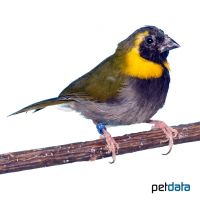Cuban Grassquit (Phonipara canora)
| Cuban Grassquit Phonipara canora | |
|---|---|
| Name | Cuban Grassquit |
| Name Lat. | Phonipara canora |
| Synonym | Tiaris canora |
| Family | Tanagers |
| Family lat. | Thraupidae |
| Order | Perching Birds |
| Order lat. | Passeriformes |
| Origin | Cuba |
| Climate | Tropical |
| Diet | Exotic Birds seed, sprouts, veggies |
| Keeping | Pair |
| Care Level | Easy |
| Reproduction | Cup nest |
| Life Span | 5-10 years |
| Protection | No |
| Metric Units | |
| Size | 9.5 cm |
| Temperature | Room temperature |
| Housing | 80 x 40 x 40 cm |
| US Units | |
| Size | 3.7" |
| Temperature | Room temperature |
| Housing | 30" x 15" x 15" |
Distribution and habitat
The Lesser Cuban Finch is native to Cuba and was introduced to the Bahamas. It inhabits the light shrubbery of forest edges but also field margins and gardens. Today it is only available as a breeding form.
Cage size
The minimum cage size is 80 x 40 x 40 cm (L x W x H) for a pair, whereby young birds are not considered until they become independent. The cage size may not be undercut even in the case of justified single keeping. For an additional 2 birds, provided they are species compatible, the floor space must be increased by 25%. The cage must be placed in a bright, draught-free and quiet place at a height of at least 80 cm (except aviaries), have a rectangular base and be opaque on three sides, aviaries on one side. An aviary is required for flocking.
Maintenance
The floor must be covered with sand, wood granulate, bark mulch or similar material and must be cleaned regularly. At least 3 perches made of wood or branches of varying thickness and height must be installed in such a way that they can only be reached by flying and that the longest possible flight distance is created. They need a bathing opportunity as well as biotope-like hiding, sleeping and nesting possibilities. It is recommended to provide them with grasses and bushes. The room temperature must not fall below 15 °C.
Diet
The species-specific food supply consists of mixed seeds, available in specialized trade as "exotic food mixture" in premium quality, in addition cob millet, germinated seeds (green panicle millet, fresh grass panicles or chickweed, also cucumber slices,) and especially for raising young egg food, insects and insect larvae (small, skinned, cut up meal beetle larvae, ant pupae, pinkies, small buffalos). Charcoal, vitamine lime, shell grit and crushed eggshells are needed as digestive aids. Drinking water must always be available in birdbaths or in stable, open containers and, like food, must be offered fresh daily in clean containers.
A varied diet promotes health and prevents deficiency symptoms.
Reproduction and breeding
The sexes are easily distinguished, in females the head and neck are not black in color.
They like to breed in biotope-like facilities such as wicker nests (bionesters) and semi-open nest boxes of medium size, or freely in branches (e.g. broom, bamboo, reeds, etc). The nesting material consists of coconut fibers, sisal, grasses, as well as animal hair and small feathers for padding. The clutch consists of 2-6 eggs, the incubation period is 11-15 days.
Important
The birds may only be kept in pairs or groups, and only in pairs during the breeding season because of their aggressive behavior toward birds of the same species
They must not be kept in a round cage. An indoor aviary with a floor space of at least 0.6 m² and 1.5 m in height is recommended.
If they are kept outside, they also need a heated shelter with a floor area of at least 1 m², which can be visited by the birds at any time. The temperature in the shelter must not fall below 15 °C and the furnishings must be similar to those used in cages
Sufficient daylight or flicker-free artificial light (stroboscopic effect) corresponding to the light spectrum of natural sunlight must be provided in rooms, including shelters. The lighting duration must be between 8 and 14 hours per day. The day-night rhythm must be observed. An adequate room climate must be provided. If caged, they should be allowed regular indoor free flight. The health condition of the birds should be checked daily
Further literature can be found in your pet store.
References
Text: Othmar Sieberer; Image: petdata
Source: BMELV (1995): Tierschutzgutachten - Mindestanforderungen an die Haltung von Kleinvögeln; ROBILLER (1986): Lexikon der Vogelhaltung, Edition Leipzig; GRUMMT & STREHLOW (2009): Zootierhaltung - Tiere in menschlicher Obhut: Vögel, Verlag Harri Deutsch
- Gemäß § 21 Abs. 5 Tierschutzgesetz idgF
